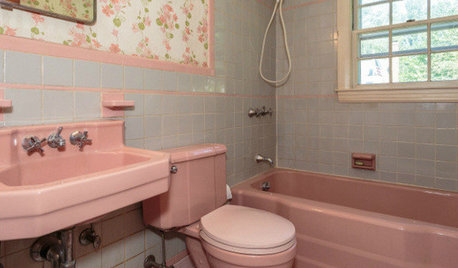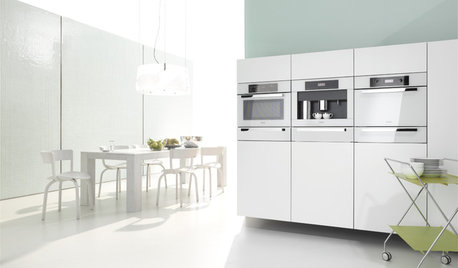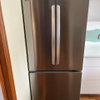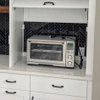I believe my original review dated Nov 19, 2009 of this DW model has scrolled off the Kitchen forum, where I mistakenly posted it (I later x-linked it in this forum as well). I updated the review on Jan 4th before it disappeared into the Black Hole of the Internet. I mentioned in both postings that I couldn't figure out why occasionally the soap dispenser didn't open - something that happened infrequently and erratically.
Well, this is why the sharing of information here is so wonderful! In a different thread on this forum where DWs were being discussed (none of which were the KA models), someone mentioned that they thought their problems were being caused by powder DW detergent that got wet while loading, which caused their DW to 'think' that there was no soap to be dispensed.
Although I use gel detergent, I wondered if by chance, this was messing my DW up as well? The soap dispenser in the KA KUDS30IVSS is placed so that when you are loading the bottom rack, moisture and/or oils can easily drip into the dispenser when it's left open. I usually put the detergent in last - my bad, obviously!
So I've been experimenting by putting in my soap first, then loading in the dishes. And every time, the soap dispenser has worked like a charm. So I think that casual tip has solved my one real problem with this otherwise excellent DW.
For anyone who is considering this model DW, I've pasted a copy of my original 11/19 review and 1/04 update.
###############
Not many people seem to have this DW. I thought I'd post a fuller review now that we've lived with it for a month. This is the model without the third-rack cutlery tray, which I wasnt interested in.
First let me say, I knew our old 1989 Kenmore/GE DW was terrible. But I never realized HOW terrible it was until we got a DW that could really clean dishes, LOL.
Pros:
- Relatively quiet (see Cons for more details).
- It actually cleans! Not only dishes with clumped-on cheese, but coffee cup rings and greasy tomato-based sauces out of Tupperware. (Gasp!) I don't have to pre-wash any longer, which means I save not only water but time.
- The Pro-scrub cycle for dirty pans (see Cons for more detail) actually works. I have cleaned dirty casserole dishes and griddle pans with it. I could never put pans in my old DW; when I pulled them out there would be a greasy film inside.
- Reasonably flexible loading (see Cons for more details) with two fold-down rows in both top and bottom racks. I really like this and use the fold-down in the bottom rack regularly.
- Top rack can be moved up or down. This was extremely important to us, because I have some really tall items that I use several times a week. The top rack stays permanently in the higher position, in our house.
- Extraordinarily hot inside, maybe because of the stainless tub (the Kenmore had a plastic tub). Despite the fact I NEVER use the Heated Dry, if I leave the dishes in for an hour or so after the cycle ends, when I pull them out they are almost completely dry.
- Apparently unfussy about detergent. They gave us some powder tablets, but I had some old Cascade gel in the pantry, and it works great with that too.
- Cycles are reasonable: 1 hr 15 min for Normal, 1 hr for Pro-Scrub (again, both without Heated Dry). I havenÂt used the Heavy Duty cycle yet. I donÂt expect to ever use the China cycle.
- We donÂt have children with greasy fingerprints, but IÂve always got dirty hands during prepping and clean-up. The stainless front is a breeze to keep clean, thanks to a microfiber cloth (tip, of course, from GW folks!).
- I took out the very long, removable cutlery holder (which also has two lidded sections for those small things that bounce around). ThereÂs a small corner basket thatÂs permanently attached. I donÂt always have a lot of flatware to wash, depending on what IÂm loading in, so I keep a small clip-on plastic basket to use as an additional flatware holder when I need it.
- I have put in a lot of small-jar lids in the upper rack, without making any real effort to brace or cover them so they donÂt flip around (a problem with my old 1989 DW, which used lots more water at higher pressure). They come clean, but donÂt move around. This also means a lot less risk of chipping. I use to hear my dinnerware clattering sometimes in the old DW, but not in this one. We have an open-plan main floor, so I was used to hearing the old DW across the room as I worked on the computer!
Cons:
- You can hear the food grinder once at start-up, and sometimes again in mid-cycle depending on how dirty the load is. It is very short, not more than 5 seconds, and much more muted than the old DW. But it is noticeable simply because the washing cycle itself is very quiet.
- Our kitchen is above our master bathroom. The DW noise is actually a little more noticeable now in the mstr bath ceiling. Not anything that keeps us up at night, but noteworthy because the old DW would gurgle in a deeper tone, mostly down the drain pipe in the wall. This new DW (which uses one-third the water) has a much quieter draining, virtually unnoticeable. But when downstairs in my master bath I can hear the gentle swishing of the wash cycle more clearly, than when I stand in the kitchen in front of the DW. It seems the ambient noise is more directed downwards, than outwards.
- Loading: The old DWÂs 'center tower' design took up room but conversely, allowed taller items to fit more easily. I do a lot of mixed loads (my sample items did not fit in the Bosch or F&P drawers) but some things just take up a lot of room, and must be fiddled with to allow the upper-rack's bottom-mounted spray arm to rotate freely.
- Loading 2: The Pro-Scrub feature only works for the two rows in the back of the bottom rack, otherwise youÂd use the Heavy-Duty cycle (which runs about 1-1/2 hrs). These are fold-down tines, and arenÂt held upright very securely. I have to brace the items in those two back rows a little more carefully as heavy items knock the tines back down if unsupported. You should also note that very tall items in those two back rows mean you need to push in the upper rack first, THEN push in the lower rack, then make certain the spray arm on the bottom of the upper rack can circulate freely. Not difficult, just something to remember as a 1-2-3 process.
- A couple of times, the soap dispenser has not opened at the right time. IÂm not sure why this has happened; it could be that something has slipped down to interfere with the sensor. I am running this DW much more often than my old one, at least once a day and sometimes twice, and all other times the dispenser has worked perfectly. IÂll keep an eye on this, and report back if it seems an actual problem is developing.
- I use a lot of homemade pesto, and occasionally little flakes of basil leaves slip through the recycling filter.
There are no audible alarms at the end of cycle, BTW; only a blue "Clean" LED that stays on until you unload the DW.
All told, we are very pleased with the KA DW. We had the moisture barrier strip installed with the DW (another GW tip). It is quiet, saves water, and works very well for the way we cook and prep.
Updated Jan 4, 2010:
I wanted to post an update now that we've run more loads through our new Kitchenaid DW. Normally six weeks might not be much of an update, but posts scroll off so fast (or just get lost these days by the server, LOL) that I thought it would be good to do this before it disappears forever.
We are still running the KA a lot more often than our (mediocre) old Kenmore/GE. The fact that it cleans the cookware, which our old DW did not do well at all, means that a lot more big items are put in, which requires running it more often.
We still have the issue with the soap dispenser not opening on rare occasions. Again, this very seldom happens, so I've been unable to figure out the "why?" The DW runs such hot water, however, with that stainless tub holding in the heat so much better than the old DW's plastic tub, that the loads have come out almost completely clean even without soap!
Egg yolk residue and mashed potatoes are a bit difficult for the DW, although it's a total champ on grease and baked-on casserole crusts. I now soak the plates that have the egg yolk or potato residue with a little water, for a few minutes (while I'm putting glasses and silverware into the DW, for example). Then I load them into the DW - no scrubbing necessary, just a little hydration.
The loads have all been on Regular or Pro Scrub cycles. I used the Heavy Duty cycle once but didn't find it was any more effective than the Pro Scrub. Virtually everything that has needed a little extra washing "ooomph" has fit into the two rows on the lower rack where the Pro Scrub cycle is aimed. On those rare occasions when an item is just too big for the Pro Scrub racks, then the Heavy Duty cycle is useful, while placing the item full-face-down on the lower rack.
I still do miss the height of my old DW - there's one or two things that simply will not fit into the KA unless I lay it face down which takes up an entire rack. But in all other respects, the KA works like a champ and has made a huge difference in less time and effort spent on daily clean-up.
With our old DW, I seldom ran it more than two or three times a week. There was so much it couldn't clean well, or that were too awkwardly shaped to fit. I really appreciate the flexible loading of the KA racks. We have so many odd or large items that are easy to fit into this DW. With the KA, I can run it twice a day because I know it will clean just about everything.
Drying:
I only have to wait 2 hrs 15 min after I push the Start button, to open up the DW and almost everything is dry (and hot to the touch!). If I wait 4 hours then the condensation drying makes everything completely dry. The one exception is the curved rims on plastic tupperware-type containers.
This is because I load the plastic containers upside-down; if I loaded them on their sides the rims would drain, but conversely make it harder for the interior to drain well. I usually unload everything else first, then take the containers out and shake the water from the rims into the sink. They air-dry completely in an hour or so, and then get put away.















madamg2u
pat_123
Related Discussions
Help me choose--KA or Bosch DW
Q
low-end DWs? Or KA Superba?
Q
Anyone have Miele DW Model G868?
Q
X-post: Review of KA DW model KUDS30IVSS
Q
lip2000
iceqween13